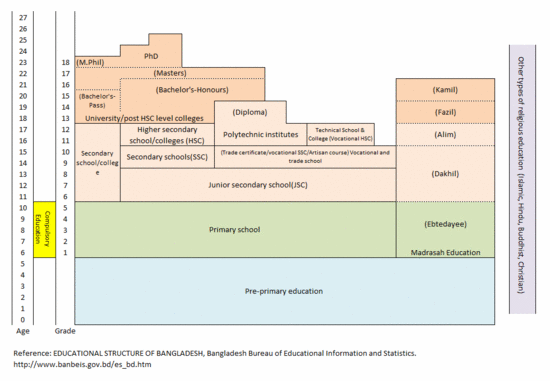| To better grasp the situation of ECEC around the world, it is essential to understand the circumstances in each country. In this section, we introduce basic information ranging from population size and educational investment in the country to educational systems, mainly focusing on the preschool phase. It is our humble hope that this information will be of some use to our readers who are interested in ECEC around the world. |
1. Capital: Dhaka
2. Population: 160 411 000 (2015)
3. Official/National Language(s): Bengali
4. Currency: Taka (BDT)
5. System of Education and Childcare
- Education system: Primary (ages 6-10), junior secondary (ages 11-13), secondary (ages 14-15), higher secondary (ages 16-17), tertiary (age 18-)
- Regulating authority: Ministry of Education (MOE) and Ministry of Primary and Mass Education (MOPME)
- Compulsory education: Ages 6-10
- Beside the general educational system, there is Madrasah education, an Arabic medium education system that emphasizes Islamic religious education.
- 3 year old: N/A
- 4 year old: N/A
- 5 year old: N/A
- 6 year old: N/A
8. Average class size
- Primary: N/A
- Pre-primary: N/A
- Primary: N/A
- PISA 2012: Not participated
- TIMSS 2011 (4th grade): Not participated

-
Reference
- 2. Population Division, United Nations. World Population Prospects: The 2012 Revision.
http://esa.un.org/unpd/wpp/unpp/panel_population.htm. - 5. "EDUCATIONAL STRUCTURE OF BANGLADESH, Bangladesh Bureau of Educational Information and Statistics. http://www.banbeis.gov.bd/es_bd.htm
- 6. OECD (2014). Education at a Glance 2014: OECD Indicators, OECD Publishing.
http://dx.doi.org/10.1787/eag-2014-en. Table C2.1 Enrolment rates in early childhood and primary education, by age (2005, 2012). http://dx.doi.org/10.1787/888933118333. - 7. OECD (2014). Education at a Glance 2014: OECD Indicators, OECD Publishing.
http://dx.doi.org/10.1787/eag-2014-en. Table B4.1. Total public expenditure on education (2011). http://dx.doi.org/10.1787/888933117573. - 8. OECD (2014). Education at a Glance 2014: OECD Indicators, OECD Publishing.
http://dx.doi.org/10.1787/eag-2014-en. Table D2.1. Average class size, by type of institution and level of education (2012). http://dx.doi.org/10.1787/888933119682. - 9. OECD (2014). Education at a Glance 2014: OECD Indicators, OECD Publishing.
http://dx.doi.org/10.1787/eag-2014-en. Table D2.2. Ratio of students to teaching staff in educational institutions (2012). http://dx.doi.org/10.1787/888933119682. - 10. OECD (2013). PISA 2012 RESULTS IN FOCUS. Snapshot of performance in mathematics, reading and science. http://www.oecd.org/pisa/keyfindings/pisa-2012-results-snapshot-volume-I-ENG.pdf.
- Martin, M.O., Mullis, I.V.S., Foy, P., & Arora, A. (2012).The TIMSS 2011 International Results in Mathematics. Chestnut Hill, MA: TIMSS & PIRLS International Study Center, Boston College. http://timssandpirls.bc.edu/timss2011/downloads/T11_IR_M_Chapter1.pdf, p.40.
- Martin, M.O., Mullis, I.V.S., Foy, P., & Stanco, G.M. (2012). The TIMSS 2011 International Results in Science. Chestnut Hill, MA: TIMSS & PIRLS International Study Center, Boston College. http://timss.bc.edu/timss2011/downloads/T11_IR_S_Chapter1.pdf, p.38.














